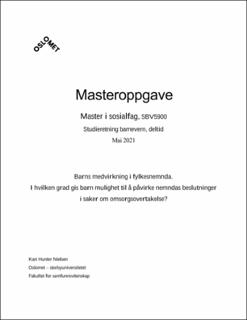| dc.contributor.advisor | Seim, Sissel | |
| dc.contributor.author | Nielsen, Kari Hunter | |
| dc.date.accessioned | 2021-10-14T11:42:26Z | |
| dc.date.available | 2021-10-14T11:42:26Z | |
| dc.date.issued | 2021 | |
| dc.identifier.uri | https://hdl.handle.net/11250/2823017 | |
| dc.description.abstract | Barns rett til medvirkning er styrket gjennom FNs konvensjon om barns rettigheter og barnevernloven. Lovgivningen gir anvisninger til hvordan medvirkning forstås og vurderes i fylkesnemnda, og at barnets synspunkter skal vektlegges ut fra barnets alder og modenhet. I denne masteroppgaven har jeg studert hvordan barns medvirkning kommer til uttrykk i fylkesnemndas vedtak, og hvordan barns meninger vurderes og vektes. Problemstillingen som belyses i oppgaven er: Hvordan kommer barns medvirkning til uttrykk i fylkesnemndssaker etter barnevernloven §4-12, i aldersgruppen fra 7-12 år? Hvordan vurderer fylkesnemnda barnets synspunkter og hvordan vektes disse i fylkesnemndas beslutninger?
Utvalget består av 11 skriftlige fylkesnemndsvedtak, som er anonymisert og ligger tilgjengelige på Lovdata. Min undersøkelse er en kvalitativ dokumentanalyse og jeg har benyttet tematisk analyse for å analysere frem mine tema og kategorier. Jeg finner i analysen at barns mulighet til å medvirke er begrenset. Barnets synspunkter synes å fremtre i størst grad i de sakene der det er samsvar mellom nemndas vurderinger og barnets synspunkter. I disse sakene vurderer nemnda barna som modne, og tillegger barnets synspunkter vekt i beslutningene. I de sakene der det ikke er samsvar mellom nemndas beslutninger og barnets meninger er barnet i større grad vurdert som umodent, og deres meninger tillegges liten vekt i beslutningene. Disse funnene belyses i sammenheng med tidligere forskning, teori og begrepene instrumentell- og symbolsk makt. Jeg ser på om det ligger bestemte syn til grunn for hvordan fylkesnemnda vurderer og vekter barnets synspunkter, og drøfter om det er grunnlag for å hevde at barns medvirkning praktiseres instrumentelt. I mitt materiale finner jeg at barnets mening er lite utslagsgivende for fylkesnemndas beslutninger. | en_US |
| dc.description.abstract | The UN Convention on the Rights of the Child and the Norwegian Child Welfare Act has strengthened children's right to participation. The legislation provides instructions on how participation is understood and assessed in the county board, and that the child’s views should be emphasized according to the child’s age and maturity. The question explored in this thesis is: How is children’s participation expressed in county board cases according to the Child Welfare Act §4-12, in the age group from 7-12 years? How does the county board assess the child’s views and how are these views weighted in the county board’s decisions?
My research is a thematic, qualitative document analysis. I have studied 11 written county board decisions about care orders, which are anonymized and available on Lovdata (Norwegian legislation database). I find in the analysis that children’s participation is limited. When the tribunal’s assessments correspond with the child’s opinions, children’s views are more clearly stated, the tribunal considers the child to be mature and emphasize their opinions in the decisions. In the cases where there is no correspondence between the tribunal’s decisions and the child’s opinions the child is more often considered immature, and their views are given little weight in the decisions.
These findings are interpreted in connection with previous research, and the theoretical concepts of instrumental and symbolic power. I argue that that children’s participation is dominated by instrumental reason: The child’s views seem not to be decisive for the county board’s decisions but is used to legitimize the decisions. This legitimization is made possible through the workings of symbolic power: the decisions not to consider the children’s opinions are understood to be in the best interest of the child. I find that children’s participation is limited, and that their views have little say in the outcome of the case. | en_US |
| dc.language.iso | nob | en_US |
| dc.publisher | OsloMet-Storbyuniversitetet | en_US |
| dc.subject | Barnevern | en_US |
| dc.subject | Medvirkning | en_US |
| dc.subject | Fylkesnemnda | en_US |
| dc.subject | Barns rettigheter | en_US |
| dc.subject | FN | en_US |
| dc.title | Barns medvirkning i fylkesnemnda. I hvilken grad gis barn mulighet til å påvirke nemndas beslutninger i saker om omsorgsovertakelse? | en_US |
| dc.title.alternative | Children's participation in the County Social Welfare board. To what extent are children given the opportunity to influence the tribunal's care order decisions? | en_US |
| dc.type | Master thesis | en_US |
| dc.description.version | publishedVersion | en_US |
